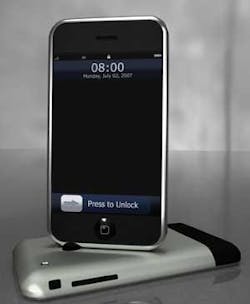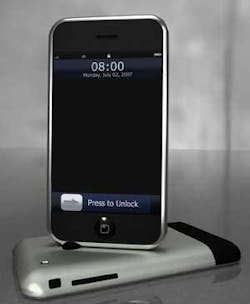What businesses can learn from the iPhone phenomenon
by John Graham
“If you’re not a reviewer, chances are you won’t even bother to look at the manual,” wrote Time reviewer Lev Grossman. That’s nothing less than a stunning comment about any cell phone, particularly one that inclludes phone, camera, Internet, wi-fi and, of course, an iPod music player.
Unless you’re 16-years-old or younger, you probably don’t use five percent of the bells and whistles on your cell phone. You probably tried when the phone was new, but found there was no way you were going to master even one page of the manual. So you gave up.
Lev adds, “It’s also the best phone that anybody ever made.” Even though he says it sounds like a sales pitch, his overall assessment of the Apple iPhone is simple: “This thing is a marvel.”
David Pogue, the New York Times. tech guy, agrees. The iPhone is “the most sophisticated, outlook-changing piece of electronics to come along in years.”
While the critics complain about the iPhone not having a video camera (just stills), a battery that cannot be removed (the same as the iPod) and, of course, the high price ($500 to $600), most of the criticisms are minor and mostly irrelevant.
Just as Apple touted its Mac as a “computer for the rest of us,” the iPhone is the cell phone for those who hate cell phones. Almost instantly, the iPhone became the standard by which consumers judged all other cell phones, even though they had never held one in their hand. Overnight, Blackberries seemed antiquated, and Treos were viewed as clunky and irrelevant.
Every cell phone on the market is being compared to the iPhone. It’s the iPod all over again. In spite of Microsoft’s efforts, it can’t move its Zune mp3 player beyond a 15 percent market share. No one ever said, “I’ve just got to have a Zune,” even though it receives very good ratings.
Even as the iPhone introduction continues, we will uncover some interesting marketing and sales messages.
1. Have a clear vision of where the customer is going. Apple has always been a customer-focused technology company. And the genius is Steve Jobs. He recognized that computers were so complicated that people needed to be trained to use them. Thus, the Mac was born. Even during the “wilderness years” when Jobs was away from the company, some of that vision continued. But it wasn’t until he returned that his vision juiced the company’s creativity.
It wasn’t just the incredibly brilliant design of the iPod that sold 100 million of them. It was the vision of the music player plus the music itself that made it work, all brought together by the iTunes software. That’s what the customer wanted.
The iPhone is an extension of that vision. Jobs understands that convergence is the key, that the customer wants everything in one handheld unit –– computer, music, video, messaging, Internet and cell phone. The desktop computer is in steady decline as laptop sales climb and smaller replaces bigger.
Will all communication and computing fit in the palm of our hand? Undoubtedly. Will Apple deliver it? A survey might just suggest that Apple rather than Microsoft has the upper hand, at least at the moment.
And by the way, does anyone really believe that Dell’s pink (or any other color) laptops are the answer to boosting sales? Consumers’ views are colored by their experience with products and service.
2. Don’t do everything at once. No one seems to understand the concept of the “never-ending roll-out.” Product introductions are almost always one-time events that soon fade from memory. It’s difficult to recall one without quite an effort.
As everyone knows, the first iPhone announcement was in January 2007, although rumors had been circulating for years. Then, about 24 hours before the iPhone went on sale, Jobs is reported to have said that the Mac computer coming out during the next year will be “off the charts.” While most marketers would have said that it was the wrong time to introduce another product, Jobs used it to ignite even more buzz.
Then came more buzz when it was announced that the iPhone would be available outside the U.S. But that wasn’t all. The critics labeled the iPhone a “consumer” product, and a number of corporate IT people said that iPhones were not on their agenda, raising the furor of countless employees. Apple’s announcement of enterprise software created more excitement. Here’s the point: employee demand will open corporate America’s door to the iPhone and it won’t cost Apple a dime. To be sure, the rolling roll-out only works if the product or service lives up to the buzz.
3. Overcome customer reluctance to make a change. Bambi Brannan, a Moderator at Mac 360 Forum, opens her June 28 commentary with, “Apple’s iPhone marketing and promotion may go down in history as text classic –– Best. Campaign. Ever ... You are witnessing history in the making.” But that’s not all. Apple understands that most companies ignore the painfully obvious. We all have an almost innate reluctance to change, other than the seven or eight percent of people who are inveterate “early adopters.”
Apple Stores are the classroom. Just because we may hate our cell phones doesn’t mean we’ll automatically shell out $500 or more for an iPhone. Our experience with cell phones doesn’t allow us to jump so quickly.
Apple understands. Thus the company announced just before iDay on June 29 that all 164 stores would be offering “free in-depth workshops, so customers can get the most out of their new iPhones. Customers will also have access to free iPhone support at the Genius Bar and personal training through Apple’s new One to One program.” That’s right, Genius Bar. You can walk in or schedule an appointment via the Internet and take your computer or iPod in without charge and have an expert work on it for you –– free.
Taking the fear out and putting customers at ease is a key to the Apple experience. As something of a sidebar, going to an Apple store is also part of the experience. Whether as a new customer or veteran with the products, there is an interesting feeling of belonging, something found in few other places. One person likened entering the store to going to church. The next time you walk by an Apple store, think about that. The only sign is an Apple logo.
4. It’s all about emotion. No matter what American automobile manufacturers do, they just can’t break loose from discounting prices to increase sales. This is not totally accurate. If there is an exception, it’s Chrysler’s Jeep. Its war-winning, break-free, go-anywhere image lies deep within the American psyche.
A colleague who drives a Pontiac G6, a highly rated American-made car, once commented that he aspires to own a Camry. Ironically, it’s now the all-American car, the standard, a position once held by Ford and Chevrolet, and made indelible by the 1970s advertising jingle of “baseball, hot dogs, apple pie and Chevrolet.” Today, Camry carries that emotional cache.
As John Martellaro wrote in a recent edition of The Mac Observer, “People who feel attracted to a device have more interest in learning about it.” According to Don Norman, an interface expert who worked at Apple in the 1990s, one of Steve Jobs’ product evaluation criteria is a user experience document.
Whether it’s an iPod or a Mac computer, it’s the experience that drives the product.
Some dismiss Apple customers as cultists, irrationally devoted to the company and its products. That’s inaccurate, even though there’s a fine book called The Cult of Mac. As a Mac user since 1984, I freely admit to be passionate about Mac computers. And why not be passionate? They’re fun. In effect, Apple has never strayed from the task of creating a pleasurable, satisfying and exciting experience for its customers. This basic quality is expressed not only in Mac computers, but is the heart of the iPod and iPhone.
There’s more to the iPhone story, of course. Nothing is perfect, even the iPhone. Reviewer Lev Grossman offered a few improvement suggestions and then added, “Cold fusion would be great too, but you know what? Nobody cares. Steve Jobs has said, repeatedly, that this is the best iPod that Apple has ever made, and it is. It’s also the best phone that anybody has ever made.”
More important, perhaps, is that Apple has sent every other smart phone manufacturer back to the drawing board. If that’s true, then every consumer wins. If iPhone did nothing more than make it unnecessary to even include a manual, we can hope that designing for customers creates winning products.
Among the thousands of comments that appeared online and in the press during the iPhone launch, two captured the moment: “The iPhone is a society-changing, watershed moment that will alter the physical universe as we know it. Pay attention.”
The second one is from San Francisco-based tech consultant Daniel Eran Dilger, who wrote, “The iPhone is simply the most incredible piece of consumer hardware I’ve ever touched ...The iPhone simply embarrasses my own expertise, which I am usually loath to admit.”
If we can learn anything from this, it’s that price is no barrier to products and services that allow customers to do what they want, perform intuitively and have fun.
John R. Graham is president of Graham Communications, a marketing services and sales consulting firm. He is the author of “The New Magnet Marketing” and “Break the Rules Selling,” writes for a variety of business publications, and speaks on business, marketing, and sales topics for company and association meetings. He is the winner of an APEX Grand Award in writing and the only two-time recipient of the Door & Hardware Institute’s Ryan Award in Business Writing. Contact him at 40 Oval Road, Quincy, MA 02170, (617) 328-0069, or [email protected]. The company’s Web site is grahamcomm.com.

